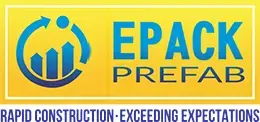When a business plans an industrial factory building, they are doing a grand investment. For them, its quite important to have the right construction approach, where they can balance cost, time, and factory’s functionality.
For this requirement, they have two options available: a structure made with traditional construction methods or a prefab factory model.
In this blog, we’ll get a cost-benefit analysis of both these ways of building a factory. We will highlight the differences and explain why a prefab factory might be the best solution for your next project.
How Does The Traditional Construction Approach Works?

Everybody knows that making a structure in the traditional approach requires you to deploy your entire resources on-site. From the ground up, the entire construction happens on the site, starting from land preparation, followed by a series of steps—building the foundation, walls, roofs, and interior elements. For this, bricks and concrete are used.
Even if there is a chance of customization, minor issues at the site can delay the project, increase the cost, and extend overall timelines. Theres are a lot of on-site complexities as well.
Key Cost Factors in Traditional Construction:
| Challenge | Description |
| Labour and Time | Labor-intensive, requiring skilled workers at every stage. Extended project completion time leads to increased labor costs and overhead expenses. |
| Material Management | Sourcing, transporting, and storing materials on-site adds significant costs. Material wastage is often higher due to on-site handling and environmental exposure. |
| Unforeseen Delays and Expenses | Weather conditions, logistical challenges, and labor availability can cause delays and unplanned expenses. Site safety and regulatory compliance also contribute to the overall cost. |
| Ongoing Maintenance | Traditional buildings may require regular maintenance due to wear and tear, exposure to environmental elements, and aging materials, adding to the building’s lifetime cost. |
Don’t just trust the word, check out how successful PEB factory looks. Visit our projects page to learn the different applications of prefab and PEB in industrial buildings.
The Prefab Factory Approach: A Modern Solution!

A Prefab Factory or Modular Factory Building involves assembling building components in a controlled factory environment before transporting them to the construction site for final assembly. This approach is gaining popularity in industrial construction due to its efficiency, cost-effectiveness, and reduced environmental impact.
Advantages of the Prefab Factory Approach:
- Cost-effective: Efficient material use & controlled labor costs lead to budget savings.
- Faster completion: Simultaneous off-site & on-site work reduces project duration.
- Consistent quality: Factory-controlled manufacturing ensures high standards & reduces defects.
- Sustainable: Minimizes waste & reduces environmental impact.
- Flexible & scalable: Adaptable design allows for easy expansion or modification.
- Energy-efficient: Can incorporate advanced insulation & systems for reduced energy use.
Comparing the Two Approaches: Prefab Factory vs. Traditional Construction
When comparing prefab factory and traditional construction methods, several key factors stand out:
| Benefit | Description |
| Time Savings | Significantly shorter construction time compared to traditional methods, leading to earlier operations, increased productivity, and minimized disruption. |
| Cost Control | Predictable budgeting with reduced risks of unexpected cost overruns due to weather delays or labor shortages. |
| Quality Assurance | Consistent quality control in the factory environment, resulting in fewer defects, reduced maintenance costs, and longer building lifespan. |
| Environmental Impact | Inherently more sustainable construction, producing less waste and reducing carbon footprint. |
Why Prefab Is Ideal for Industrial Factory Buildings?
Given these advantages, it is clear why the prefab approach is often the preferred choice for industrial factory buildings. It offers a more cost-effective, time-efficient, and sustainable alternative to traditional methods, making it well-suited for various industrial applications.
As a leading factory building manufacturer, EPACK Prefab specializes in delivering end-to-end prefab solutions tailored to the unique needs of commercial projects, from warehouses and industrial sheds to specialized buildings like clean rooms and cold storage facilities.
Make the Right Choice for Your Project!
When you decide between traditional construction and a prefab factory for your next industrial factory building, think of the short and long term benefits. Even if traditional methods offer customization and are more prevalent, its important to understand that prefab factory has far more benefits to offer. It can be built faster, and relocated easily when needed. EPACK Prefab is in the PEB industry for past 24+ years and has delivered 7400+ projects. Based on prefab and PEB, it has made new factory buildings, warehouses, and modular industrial spaces, among many other complex projects. For project enquiries or orders, contact us at +918130444466 or enquiry@epack.in, and we’ll take it up from there!











